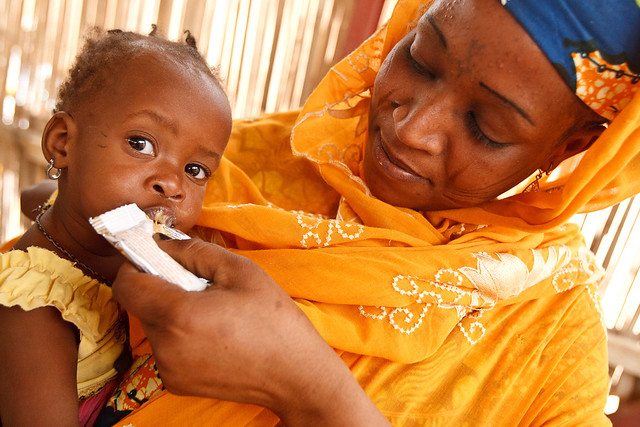A friend of mine sent me a link to this paper titled “Ready-to-use food-allocation policy to reduce the effects of childhood undernutrition in developing countries” – originally more as a “look at what weird things get published” link, but as I read through the abstract, it got me thinking…

Image by UNICEF/Olivier Asselin, via Flickr CC.
The paper’s authors try to optimize the allocation of supplementary food aid to combat malnutrition in children using a mathematical model. To do this, they used “real-life” data from 5,657 children from Bwamanda in the Democratic Republic of the Congo – they tracked the children’s height-for-age and weight-for-height over the first five years of life, as well as how much ready-to-use (therapeutic and supplementary) foods they were given. Then, they used the computer’s calculation powers to see which food distribution guideline would lead to the smallest overall loss in disability-adjusted life years (DALYs) through childhood mortality and stunting for a given budget. Alternatively, they calculated what the lowest budget would be that the aid agencies’ current performance could be reached at.
Their calculations showed that if aid agencies were to take into account age and both height-for-age and weight-for-height (instead of just weight-for-height and age as they are currently doing) and only focused on therapeutic (and not supplementary) foods, they could “reduce the number of DALYs [disability-adjusted life years] by 9% (for the same budget) or alternatively incur the same number of DALYs with a 61% reduction in cost.”
Yet, somehow this extremely utilitarian approach sat wrong with me, although rationally I know that this is the approach that is in essence necessary for humanitarian aid, since you cannot help everybody and it is reasonable to have as a goal to provide the most help with the limited resources you have.
But what would focusing only on therapeutic food aid mean? According to the WHO, therapeutic feedings aim to “rehabilitate severely malnourished persons. The main aim is to reduce excess mortality. In most emergency situations, the majority of those with severe wasting are young children. There have, however, been cases where large numbers of adolescents and adults have become wasted. In such situations, separate TFP facilities may be established for these groups.”
On the other hand, “Supplementary Feeding Programmes (SFPs) provide nutritious food in addition to the general ration. They aim to rehabilitate malnourished persons or to prevent a deterioration of nutritional status of those most at-risk by meeting their additional needs, focusing particularly on young children, pregnant women and nursing mothers.”
Thus, if following the economists, you would only take care of the most severe cases because they are closest to death, and focus less on the cases that are “only” at risk of malnutrition.
Reading through these guidelines is eye-opening in itself, since you realize that even without economic optimization, there are strict rules and cut-off limits in place. Of course, this is necessary in order to remain fair and avoid making emotional decisions, but I am still unsure whether I could turn away a clearly undernourished child from my feeding centre just because they missed a certain weight-for-height statistical goal. I wonder how much these guidelines are followed in the field.
What do you think? Is the optimization of food aid strategies a great tool to achieve the maximum help in the situation, or is it too close to gambling with people’s lives?
This is a difficult issue since in real terms it is not possible to help everyone, even in times of severe crisis. Optimizing benefit not reducing cost should be the goal here.